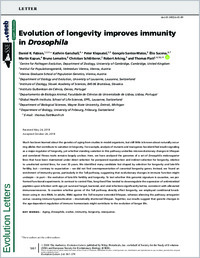Evolution of longevity improves immunity in Drosophila
- Fabian, Daniel K. Centre for Pathogen Evolution, Department of Zoology, University of Cambridge, Cambridge United Kingdom - Institut für Populationsgenetik, Vetmeduni Vienna, Austria - Vienna Graduate School of Population Genetics Austria
- Garschall, Kathrin Department of Ecology and Evolution, University of Lausanne, Switzerland
- Klepsatel, Peter Institut für Populationsgenetik, Vetmeduni Vienna, Austria - Institute of Zoology, Slovak Academy of Sciences, Bratislava, Slovakia
- Santos-Matos, Gonçalo Instituto Gulbenkian de Ciência, Oeiras, Portugal
- Sucena, Élio Instituto Gulbenkian de Ciência, Oeiras Portugal - Departamento de Biologia Animal, Faculdade de Ciências da Universidade de Lisboa, Portugal
- Kapun, Martin Department of Ecology and Evolution, University of Lausanne, Switzerland
- Lemaitre, Bruno Global Health Institute, School of Life Sciences, EPFL, Lausanne Switzerland
- Schlötterer, Christian Institut für Populationsgenetik, Vetmeduni Vienna, Austria
- Arking, Robert Department of Biological Sciences, Wayne State University, Detroit Michigan
- Flatt, Thomas Institut für Populationsgenetik, Vetmeduni Vienna, Austria - Department of Ecology and Evolution, University of Lausanne, Switzerland - Department of Biology, University of Fribourg, Switzerland
-
12.11.2018
Published in:
- Evolution Letters. - 2018, vol. 2, no. 6, p. 567–579
English
Much has been learned about the genetics of aging from studies in model organisms, but still little is known about naturally occurring alleles that contribute to variation in longevity. For example, analysis of mutants and transgenes has identified insulin signaling as a major regulator of longevity, yet whether standing variation in this pathway underlies microevolutionary changes in lifespan and correlated fitness traits remains largely unclear. Here, we have analyzed the genomes of a set of Drosophila melanogaster lines that have been maintained under direct selection for postponed reproduction and indirect selection for longevity, relative to unselected control lines, for over 35 years. We identified many candidate loci shaped by selection for longevity and late‐life fertility, but – contrary to expectation – we did not find overrepresentation of canonical longevity genes. Instead, we found an enrichment of immunity genes, particularly in the Toll pathway, suggesting that evolutionary changes in immune function might underpin – in part – the evolution of late‐life fertility and longevity. To test whether this genomic signature is causative, we performed functional experiments. In contrast to control flies, long‐lived flies tended to downregulate the expression of antimicrobial peptides upon infection with age yet survived fungal, bacterial, and viral infections significantly better, consistent with alleviated immunosenescence. To examine whether genes of the Toll pathway directly affect longevity, we employed conditional knockdown using in vivo RNAi. In adults, RNAi against the Toll receptor extended lifespan, whereas silencing the pathway antagonist cactus‐–causing immune hyperactivation – dramatically shortened lifespan. Together, our results suggest that genetic changes in the age‐dependent regulation of immune homeostasis might contribute to the evolution of longer life.
- Faculty
- Faculté des sciences et de médecine
- Department
- Département de Biologie
- Language
-
- English
- Classification
- Biological sciences
- License
- License undefined
- Identifiers
-
- RERO DOC 323782
- DOI 10.1002/evl3.89
- Persistent URL
- https://folia.unifr.ch/unifr/documents/307288
Statistics
Document views: 144
File downloads:
- fla_eli.pdf: 132
